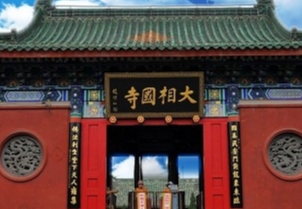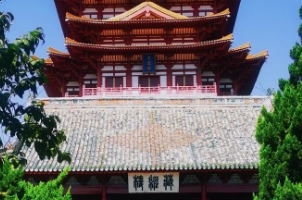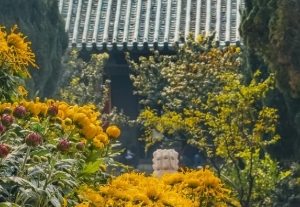Daxiangguo Temple, originally known as Jianguo Temple, was first established in 555 AD during the Northern Qi Dynasty. It was renamed Daxiangguo Temple in 712 AD during the Tang Dynasty. By the Northern Song Dynasty, the temple reached its zenith, becoming the national center of Buddhist activities and the first royal temple in Chinese history to hold state-sponsored ceremonies.
The temple is laid out along a central axis, with its main structures including the Hall of Devarajas, the Hall of Tathagate, the Octagonal Glazed Hall and the Hall of Tripitaka.
Daxiangguo Temple is not only a Buddhist sanctuary but also a hub of cultural exchange. The renowned Tang Dynasty monk Kukai studied Buddhism here and later introduced it to Japan, where he developed the Japanese script known as Katakana. Additionally, the temple is famously mentioned in the classic novel The Water Margin, where the character Lu Zhishen uproots a willow tree in its courtyard.
Located in the heart of Kaifeng, Daxiangguo Temple boasts magnificent architecture and a rich collection of cultural relics, making it an exceptional destination for visitors to explore Buddhist culture and history.
Opening Hours:
Summer (March 11 – October 31): 8:00 AM – 6:30 PM
Winter (November 1 – March 10): 8:00 AM – 6:00 PM
Visiting Route: Front Gate → Hall of Devarajas → Hall of Tathagate→ Octagonal Glazed Hall→ Hall of Tripitaka
-
Official phone number: 0371-25978502 & 0371-22733099
Must-see Highlights
Octagonal Glazed Hall
The Octagonal Glazed Hall, often referred to as the Hall of Arhat , is the iconic centerpiece of Daxiangguo Temple. Inside, it houses a magnificent 6-meter-tall wooden statue of a four-sided, thousand-armed, and thousand-eyed Avalokiteshvara Bodhisattva. Carved from a single gingko tree during the Qing Dynasty under Emperor Qianlong’s reign, this statue is considered the temple’s most treasured artifact. Each side features six large hands and over 200 smaller hands, each adorned with a symbolic "wisdom eye," showcasing exquisite craftsmanship.
Hall of Tathagate
Built in 1661, the Hall of Tathagate is the temple’s main hall and is renowned as the "First Hall of Central China." It enshrines the statues of the Eighteen Arhats on its eastern and western walls, with a statue of Island Avalokiteśvara Statue at the rear. Beyond being a central site for religious ceremonies, the hall frequently hosts cultural exhibitions and displays of historical artifacts.
Hall of Tripitaka
The Hall of Tripitaka, a two-story structure with double-eaved roofs, is one of the temple’s most significant buildings. It houses the Qianlong Tripitaka and features a stunning white jade statue of Sakyamuni Buddha, a precious gift from a Singaporean monk. The statue’s intricate design and serene expression make it a highlight of the depository.
Hall of Devarajas
Constructed in 1776, the Hall of Devarajas is the first building visitors encounter upon entering the temple. It enshrines the Four Devarajas and the Maitreya Buddha. In front of the hall stand the Bell and Drum Towers, with the Bell Tower housing a massive Qing Dynasty bronze bell weighing over 10,000 pounds. The bell’s resonant tolls are celebrated as one of Kaifeng’s Eight Scenic Wonders, known as "Xiangguo’s Frost Bell."


Things to Do
Chrysanthemum Culture Festival
From October 18 to November 18 each year, Daxiangguo Temple hosts the Chrysanthemum Culture Festival. During this time, the temple grounds are adorned with exquisite chrysanthemum displays, creating a vibrant autumn atmosphere that captivates visitors.
Bell-ringing Ceremony
On New Year’s Eve, from 7:00 PM to 2:00 AM, the temple opens its gates for a special bell-ringing ceremony. Visitors can participate in this traditional event, listening to the resonant bell tolls to welcome the new year with blessings and good fortune
Lantern Festival Celebration
During the annual Lantern Festival, Daxiangguo Temple comes alive with a grand lantern display. The temple is decorated with colorful lanterns, accompanied by festive music and performances, offering visitors a lively and immersive experience of traditional Chinese culture.
Buddhist Music Performances
Daxiangguo Temple’s Buddhist music, recognized as a national intangible cultural heritage, is performed at specific times for visitors. These serene and melodic performances, usually held in front of the Hall of Tripitaka, provide a unique opportunity to experience the spiritual and cultural essence of Buddhism.
Best Time to Visit Daxiangguo Temple
The best time to visit Daxiangguo Temple is during spring and autumn, particularly from September to November.
During these months, the weather is cool and pleasant, making it ideal for strolling through the temple and admiring the grandeur of its ancient architecture.
Additionally, autumn in Kaifeng is marked by the Chrysanthemum Culture Festival, during which the temple is adorned with stunning chrysanthemum displays, adding a vibrant and festive atmosphere to the serene surroundings.

Transportation Guide
By Air
Kaifeng does not have its own airport, but it is conveniently located near Zhengzhou Xinzheng International Airport, approximately a 1-hour drive away.By High-Speed Rail / Train
High-Speed Rail: Take a high-speed train from Zhengzhou East Station to Kaifeng North Station, with a travel time of about 15 minutes.
Regular Train: Direct trains to Kaifeng Station are available from various cities across China, with travel times varying depending on the departure location.
By Long-Distance Bus
Zhengzhou to Kaifeng:The Zhengzhou-Kaifeng intercity bus runs every 15 minutes, with a journey time of around 30 minutes.
Other Cities: Direct buses connect Kaifeng with cities like Luoyang and Shangqiu, taking approximately 1-2 hours.
Travel Tips
The temple often hosts traditional Buddhist music performances. Check the schedule in advance to enjoy these serene melodies, which perfectly complement the tranquil and sacred atmosphere of this ancient site.
With its rich displays of Buddhist culture and history, the temple offers a fascinating journey into the past. Allocate 1-2 hours to fully explore and appreciate its spiritual and historical significance.
Nearby, the historic Drum Tower Night Market offers a chance to savor Kaifeng’s local delicacies and experience the vibrant culture of the city.
Note
As a place of religious worship, the temple requires a quiet and respectful atmosphere. Please refrain from loud noises and avoid touching cultural relics to preserve their sanctity.
Visitors are encouraged to dress modestly and avoid wearing overly revealing or inappropriate clothing.
Photography may be restricted in certain areas. Please observe posted signs and adhere to the temple’s regulations.




































